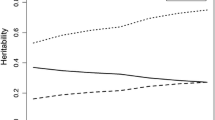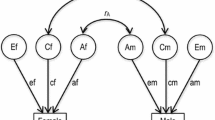Abstract
The present study assesses the genetic and environmental etiologies of reading, rapid naming (RN), and their covariation by fitting multivariate structural equation models to data from 587 twin pairs in which at least one member of the pair exhibited reading difficulties (low-range) and from 360 control (normal-range) twin pairs who were tested in the Colorado Learning Disabilities Research Center. Results from a bivariate phenotypic analysis with two hypothesized latent factors, READ and RN, indicated that the correlation between reading and rapid naming performance for the low-range sample was significantly higher than that of the normal-range sample. When this model was partitioned to include estimates of genetic, shared environmental, and nonshared environmental influences, resulting heritability estimates did not differ significantly for the low-range and normal-range samples for either READ or RN. However, similar to the phenotypic correlation, the genetic correlation between the READ and RN latent factors could not be equated for the two groups. Thus, the etiology of the relationship between reading performance and rapid naming may differ for children with reading difficulties and normally-achieving readers. Moreover, these results support previous findings that the best predictors of reading skills may differ for samples of children with normal reading levels and those with reading difficulties.
Similar content being viewed by others
References
Badian, N. A. (1993). Phonemic awareness, naming, visual symbol processing, and reading. Reading and Writing: An Interdisciplinary Journal, 5, 87–100.
Blachman, B. A. (1984). Relationship of rapid naming ability and language analysis skills to kindergarten and first-grade reading achievement. Journal of Educational Psychology, 76, 610–622.
Compton, D. L., Olson, R. K., & DeFries, J. C. (under review). Are all RAN created equal? Comparing the relationships among two different formats of alphanumeric RAN and various word reading skills in normally achieving and reading disabled individuals.
Cornwall, A. (1992). The relationship of phonological awareness, rapid naming, and verbal memory to severe reading and spelling disability. Journal of Learning Disabilities, 25, 532–538.
DeFries, J. C. (1985). Colorado reading project. In D. B. Gray & J. F. Kavavagh (eds.), Biobehavioral measures of dyslexia (pp. 107–122). Parkton, MD: York Press.
DeFries, J. C., & Alarcón, M. (1996). Genetics of specific reading disability. Mental Retardation and Developmental Disabilities Research Reviews, 2, 39–47.
DeFries, J. C., Filipek, P. A., Fulker, D. W., Olson, R. K., Pennington, B. F., Smith, S. D., & Wise, B. W. (1997). Colorado Learning Disabilities Research Center. Learning Disabilities: A Multidisciplinary Journal, 8, 7–19.
Denckla, M. B. (1972). Color-naming defects in dyslexia boys. Cortex, 10, 186–202.
Denckla, M. B., & Rudel, R. G. (1976). Rapid “automatized” naming (r.a.n.): Dyslexia differentiated from other learning disabilities. Neuropsychologia, 14, 471–479.
Dunn, L. M., & Markwardt, F. C. (1970). Examiner’s manual: Peabody individual achievement test. Circle Pines, Minnesota: American Guidance Service.
Korhonen, T. T. (1995). The persistence of rapid naming problems in children with reading disabilities: A nine-year follow-up. Journal of Learning Disabilities, 28, 232–239.
Mcbride-Chang, C., & Manis, F. R. (1996). Structural invariance in the associations of naming speed, phonological awareness, and verbal reasoning in good and poor readers: A test of the double deficit hypothesis. Reading and Writing: An Interdisciplinary Journal, 8, 323–339.
Meyer, M. S., Wood, F. B., Hart, L. A., & Felton, R. H. (1998). Selective predictive value of rapid naming in poor readers. Journal of Learning Disabilities, 31, 106–117.
Neale, M. C. (1999). Mx: Statistical modeling, 5th edition. Box 126 MCV, Richmond, VA, 23298: Department of Psychiatry.
Neale, M. C., & Cardon, L. R. (1992). Methodology for genetic studies of twins and families. Boston: Kluwer Academic Publishers.
Nichols, R. C., & Bilbro, W. C. (1966). The diagnosis of twin zygosity. Acta Genetica et Statistica Medica, 16, 265–275.
Scarborough, H. S. (1998). Predicting the future achievement of second graders with reading disabilities: Contributions of phonemic awareness, verbal memory, rapid naming, and IQ. Annals of Dyslexia, 48, 115–136.
Snyder, L. S., & Downey, D. M. (1995). Serial rapid naming skills in children with reading disabilities. Annals of Dyslexia, 45, 31–49.
Spring, C., & Capps, C. (1974). Encoding speed, rehearsal, and probed recall of dyslexic boys. Journal of Educational Psychology, 66, 780–786.
SPSS-X. (1988). Statistical package for the social sciences (3rd ed.) [computer program]. Chicago: SPSS Inc.
Wolf, M. (1986). Rapid alternating stimulus naming in the developmental dyslexias. Brain and Language, 27, 360–379.
Wolf, M., Bowers, P. G., & Biddle, K. (2000). Naming-speed processes, timing, and reading: A conceptual review. Journal of Learning Disabilities, 33, 322–324.
Author information
Authors and Affiliations
Corresponding author
Rights and permissions
About this article
Cite this article
Davis, C.J., Knopik, V.S., Olson, R.K. et al. Genetic and environmental influences on rapid naming and reading ability: A twin study. Ann. of Dyslexia 51, 231–247 (2001). https://doi.org/10.1007/s11881-001-0012-3
Issue Date:
DOI: https://doi.org/10.1007/s11881-001-0012-3




